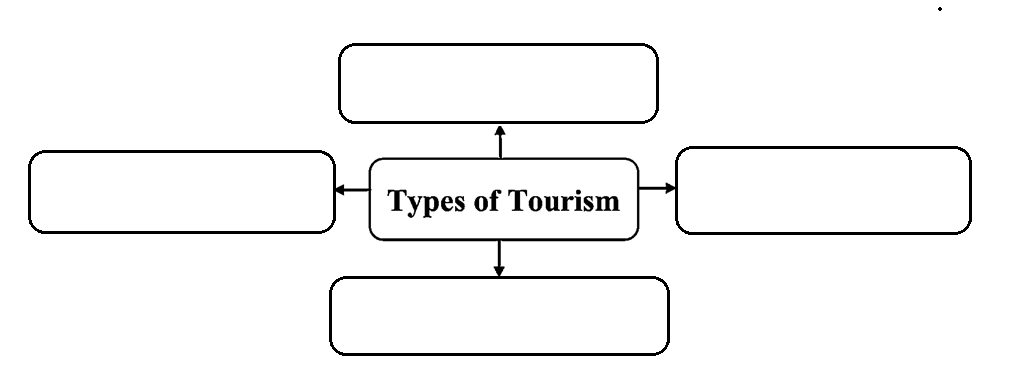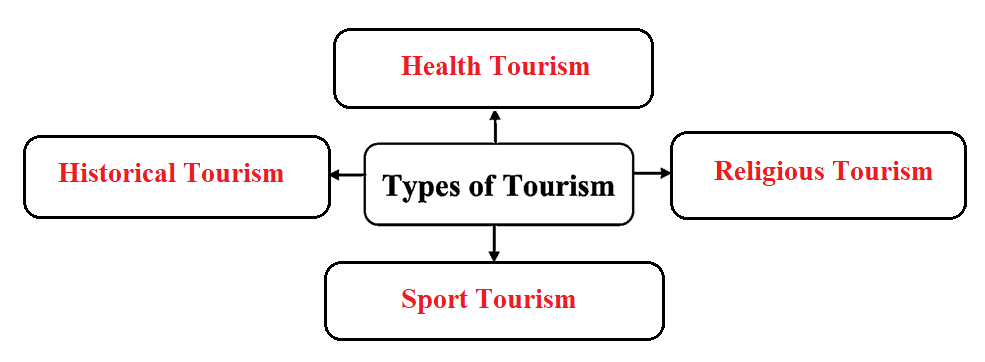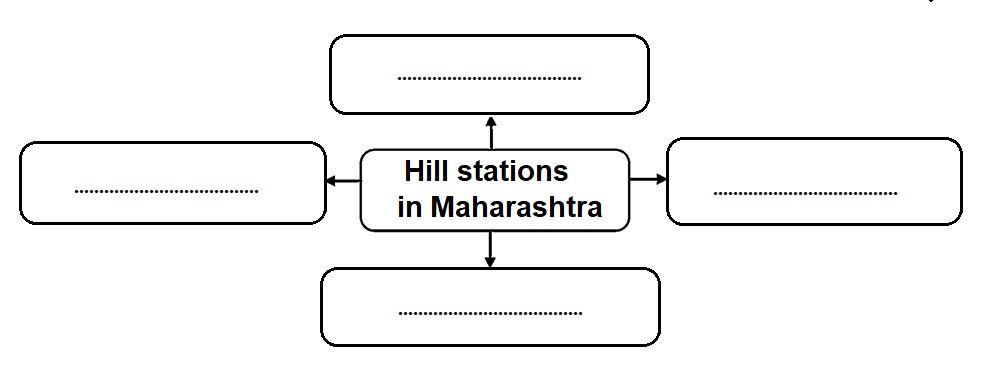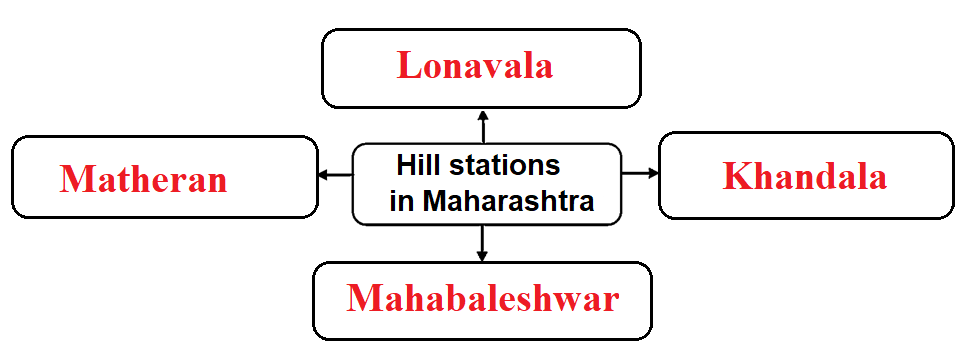Chapter 8 : Tourism And History
Q.1. (A) Complete the sentences by choosing the correct option.
1. Thomas Cook established a travel agency selling ……………
(A) handicrafts (B) toys (C) food items (D) tourist tickets
2. Bhilar is known as the ‘Village of ……………’
(A) books (B) plants (C) mangoes (D) forts
3. In 16th century …………… was a famous cartographer.
(A) Benjamin Tudela (B) Marco Polo (C) Gerardus Mercator (D) IbnBatuta
(B) Identify the wrong pair in the following and write.
1.
(1) Matheran – Hill Station
(2) Tadoba – Rock-cut Caves
(3) Kolhapur – Pilgrim Centre
(4) Ajanta – World Heritage
Ans: Wrong pair: Tadoba – Rock-cut Caves
2.
(1) Hiking tours to forts – Agro Tourism
(2) Visit to crater lake at Lonar – Geographic Tourism
(3) ‘Himalayan Car Rally’- Sports Tourism
(4) Film festivals – Tourism based on Special Events
Ans: Wrong pair: Hiking tours to forts – Agro-Tourism
2 (A) Complete the following Concept chart :

Ans.

2. Complete the concept map.

Ans.

Q.2. (B) Write notes :
1. Tradition of Travelling
Ans: Travelling to and staying in places outside the usual environment for a specific purpose and for a fixed period of time is known as ‘tourism’,
(1) The tradition of travelling from corner to corner can be seen in India since ancient times. This can be explained according to various time periods as follows:
a. In Ancient period:
In the ancient period, people travelled for various reasons like pilgrimage, trade, visiting local fairs & festivals, searching a renowned teacher and obtaining good education, etc. Buddhist monks, Jain monks and sadhus travelled continuously to different places. In 630 C.E., the Chinese monk, Yuan Shwang travelled to India.
b. In Medieval Period:
Saint Namdev, Saint Eknath, Guru Nanak and Ramdas Swami travelled during the medieval period,
c. In Modern Period:
Vishnubhat Godse travelled during times of the Indian war of Independence in 1857.
(2) Foreign Travellers: The tradition of travelling can be seen not only in India but also in foreign countries. Benjamin of Tudela, Marco Polo, Ibn Batuta, Geradus Mercator navigated around the world.
(3) This tradition of travelling which started since ancient times led to the development of modern tourism.
2. Marco Polo
Ans:
(1) Marco Polo was the Italian traveller of the 13 century. He travelled to China and stayed there for 17 years.
(2) He introduced Asia, especially China to Europe.
(3) He wrote about the flora & fauna, social life, culture and trade systems of Asia.
(4) This led to the development of communication and trade between Europe and Asia.
3. Agro-tourism
Ans:
(1) Today Agro-tourism, also known as Agri-tourism, is rapidly developing.
(2) It is specially meant for the urban population who have very little exposure to rural life and agriculture.
(3) Indian fanners, nowadays, visit distant regions like the agricultural research centres, agricultural-universities.
(4) Farmers also visit countries like Israel where experimentation in advanced technology of agriculture is carried out.
4. Sports tourism
Ans:
(1) Sports Tourism, developed in the 20th century, refers to travel which involves attending a sporting event.
(2) Various sports events are organised at the international level, national level and state level.
(3) Olympics, Wimbledon, World Chess Championship matches and International Cricket Tournaments etc., are some examples of sports events organised at the international level; event like Himalayan Car Rally is organised at the national level and the Maharashtra Kesari Wrestling competitions, etc; are organised at the state level.
Q.3. Explain the following statements with reasons.
1. The number of people travelling back and forth from India has increased considerably.
Ans:
(1) The availability of railway, marine and air transport, has made travelling abroad easier.
(2) There is a trans-European railway route.
(3) Marine transport has linked the coastal regions and aviation has brought the entire world closer.
(4) Also, due to the economic liberalisation policy of the Indian government, travelling abroad has become easier than before.
Therefore, the number of people travelling back and forth from India has increased considerably.
2. It is important to take a few primary precautions in order to preserve the historical heritage sites.
Ans:
(1) The concept of natural heritage gives importance to the thought of biodiversity whereas cultural heritage gives importance to human creation.
For e.g. western Ghat is the natural heritage whereas many monuments are cultural heritage.
(2) The historical sites help in understanding the contributions or achievements of our ancestors. Hence, they should be preserved for future generations. Moreover, when a heritage site is declared as a World Heritage site, it makes everyone feel proud about it.
Therefore, it is important to take a few primary precautions in order to preserve the historical heritage sites.
4. Read the following extract and answer the questions.
An unusual Village of Books
Bhilar is a village near Mahabaleshwar, which boasts of natural beauty and sweetness of strawberry. It is also known as the ‘Village of Books’. Every household in this village maintains a library of its own for the tourists to enjoy. Maharashtra State Government has implemented this scheme with a view to accelerate the ‘Reading
Culture’ movement for the reader-tourists to enjoy the beauty of Marathi literature enriched by the works of old and new authors and saints. It includes various
types of texts like biographies, autobiographies, fiction, poetry, literature by women, literature on sports, literature for kids, etc. If you go to Mahabaleshwar,
make it a point to visit Bhilar as well.
1. Write two natural features of Bhilar.
Ans: Two natural features of Bhilar are: (1) Boast of natural beauty (2) Sweetness of strawberry
2. Which is the famous hill station near Bhilar?
Ans: Bhilar is near to Mahabaleshwar, the famous hill station.
3. How Bhilar village adds to the reading culture of Maharashtra?
Ans:
(1) In Bhilar village every household maintains a library of its own for tourists to enjoy.
(2) Maharashtra State Government has implemented this scheme:
a. To accelerate the ‘Reading Culture’ movements for the reader-tourist
b. To enable them to enjoy the beauty of Marathi literature enriched by the works of old and new authors and saints
(3) It includes various types of texts like biographies, autobiographies, fiction, poetry, literature by women, literature on sports, literature for kids, etc.
Q.5. Give elaborate answers to the following.
1. What should we do to increase Tourism?
Ans: We should do following to increase tourism:
(1) The historical sites should be preserved by avoiding few things like vandalising or defacing the heritage monuments and sites, writing on walls, carving on trees, painting ancient monuments in garish colours, etc.
(2) The tourists should abide by the rules and regulations laid by the concerned authorities of the historical site. Also, proper social conduct is expected from them during the tour and during their stay at destination places.
(3) The tourists, whether national or international, should be provided with pamphlets, guides and history books that give them the information about a tourist site in their own language.
(4) Also, the taxi drivers should be trained as tourist guides. They should be able to converse in more than one language.
(5) The tourists (including handicapped tourists) should be ensured safe transport and security facilities.
(6) The tourists should be provided with decent accommodation, proper amenities and clean washroom facilities on the travel routes as well as in the premises of the heritage sites, so as to avoid filthiness in that area.
2. Describe any three types of tourism.
Ans: Introduction: Tourism can be defined as travelling to visit places in distant regions for specific purpose. The three types of tourism are as follows:
(1) International Tourism
a. International tourism is an important type of tourism. It refers to tourism that crosses national borders.
b. Due to the availability of railway, marine and air transport, it has become easier to travel abroad. There is a trans-European railway route. Marine
transport has linked the coastal regions and aviation has brought the entire world closer.
c. Moreover, due to the economic liberalisation policy of the Indian government (1991), the number of people travelling back and forth from India has increased greatly. People nowadays travel for studies, relaxation, sightseeing, shooting of films, professional assignments like meeting, agreements, etc.
d. Various official documents are to be obtained for travelling abroad, for example- passport, visa etc.
(2) Historical Tourism
a. Historical tourism refers to a kind of tourism, where the tour focuses on the history; history of some place, people, things or events. It helps people satisfy their interest in history.
b. In India, tours are arranged to different historical places and important historical sites such as forts in Rajasthan, ashrams of Mahatma Gandhi and Acharya Vinoba Bhave, important places related to the Indian War of Independence (1857), etc.
c. Gopal Neelkanth Dandekar, a renowned Marathi writer, used to arrange hiking tours to forts in Maharashtra, to explore the sights closely linked to Chhatrapati Shivaji Maharaj and his achievements.
(3) Geographic Tourism
a. Geographic tourism involves visiting places to observe the special geographical features of a region.
b. In order to satisfy this curiosity, tourists visit various natural & animal sanctuaries, beaches and unique geographical wonders like the Crater lake at Lonar & Ranjan Khalge (naturally carved out cavities in rocks) at Nighoj in Maharashtra.
Conclusion: Hence, in this way tourism not only boost the spirit of an individual but also enhances the economy of nation.
3. In what way tourism becomes a major source of their livelihood?
Ans:
(1) With the development of a tourist centre, the markets in the locality also grows.
(2) It leads to the expansion of local handicrafts and cottage industries.
(3) Moreover, the demand for locally processed food and ethnic handicrafts also increases.
(4) All these developments create good employment opportunities for large number of people like the artisans, business people and wage earners.
Thus, tourism industry helps in the generation of employment opportunities at the local level.
4. Discuss the career opportunities in tourism.
Ans: Tourism and Hospitality industry creates maximum employment opportunities. Some of the professional fields associated with tourism are as follows:
(1) Hotel Industry: This industry ensures the hospitality of tourists through proper arrangement of food and stay.
(2) Tour guide: A tour guide is a person who guides tourists in their language (or the language of their choice) that is, he works as a translator and presents the cultural and natural sights of the area.
(3) Tour operator: A tour operator typically combines tour and travel components to create holiday packages. He or she will deal with various service providers, including bus operators, airlines and hoteliers.
(4) Local Businesses: Tourism gives impetus to local businesses like handicrafts, etc.